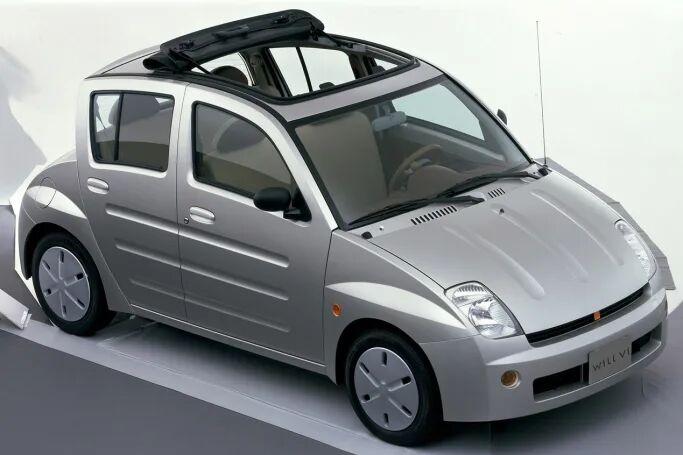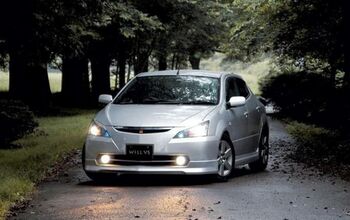Abandoned History: The Early 2000s WiLL Project, for The Youths (Part II)

The WiLL project was a short-lived collaborative marketing effort by several Japanese brands, intended to capture the interest and money of youthful buyers. Using emotional engineering, seven companies launched new products in the early 2000s wearing WiLL sub-branding. Included in the myriad of offerings were three different subcompact Toyotas.
And here’s the first one, the WiLL Vi.
Toyota started production on the new Vi in January 2000, just a few months after WiLL branding was unleashed upon the public. Much like the Nissan Pike cars, Toyota’s WiLL Vi was exceedingly retro, exceedingly cutesy, and was a more costly variant of a common hatchback. With no Toyota badges at all, Vi drew elements from Fifties cars like the Ford Anglia and Citroën 2CV. It was designed by a new division within Toyota: Virtual Venture Company.
The Virtual Venture Company was established in August of 1997 with a specific goal: Target youthful customers (under age 30) with products in the twenty-first century. A group of 40 younger Toyota employees would form project teams to assess the needs of younger customers. Importantly, this very organized effort would operate outside the traditional Toyota workflow. Toyota saw a need for serious internal changes to its decision-making structure if it was to remain competitive. Per Toyota, with the implementation of VVC, the company “hopes to maintain its position as a vigorous corporation into the next century.”
And what was more vigorous than the design of the WiLL Vi? The new body rode atop the existing Toyota Vitz platform (Echo to you), a new subcompact itself that went on sale for the model year 1999. Unlike the Vitz which offered a range of engines and manual or automatic transmissions, the Vi was restricted in a drive train sense. Like the Pike cars years before, all Vis used an automatic transmission (four speeds). There was a single-engine: a 1.3-liter inline-four from the middle of the Vitz range. Good engine, by the way, has won awards.
The WiLL Vi was quite a bit larger outside than the Vitz, though the two cars shared an identical wheelbase. Vi had an overall length of 148 inches, where the Vitz was 142.3″. If you’ve ever been to Japan, you’d know tiny cars are popular there for a reason, and six extra inches of length makes all the difference in parking. Unlike the Vitz, the Vi was painted only in pastel colors, with mandatory wheel covers of a sand dollar motif. Other required motifs included… bread. Exterior and interior panel details had indentations and color theming inspired by some classic French fare: the baguette.
The automatic transmissions allowed the installation of retro-friendly bench seating. Customers feeling especially flush in their youth could opt for a canvas sliding roof like an old French car. Maybe eat a baguette in there, really lean into the whole “I am a retro Frenchist” image.
VVC thought about the WiLL Vi a bit too hard and overshot with their premier product. It was also expensive: around $3,000 more than a comparable Vitz, which was less embarrassing to drive around town. The Vi sold so poorly it was almost immediately canceled; its production ran from January 2000 through December 2001. Vi was replaced by something slightly less out-there-French.
More in Part III, but you can take a look at a WiLL Vi in all its pink glory here. It sold back in April for $2,860 which was really not bad.
[Images: Toyota]

Interested in lots of cars and their various historical contexts. Started writing articles for TTAC in late 2016, when my first posts were QOTDs. From there I started a few new series like Rare Rides, Buy/Drive/Burn, Abandoned History, and most recently Rare Rides Icons. Operating from a home base in Cincinnati, Ohio, a relative auto journalist dead zone. Many of my articles are prompted by something I'll see on social media that sparks my interest and causes me to research. Finding articles and information from the early days of the internet and beyond that covers the little details lost to time: trim packages, color and wheel choices, interior fabrics. Beyond those, I'm fascinated by automotive industry experiments, both failures and successes. Lately I've taken an interest in AI, and generating "what if" type images for car models long dead. Reincarnating a modern Toyota Paseo, Lincoln Mark IX, or Isuzu Trooper through a text prompt is fun. Fun to post them on Twitter too, and watch people overreact. To that end, the social media I use most is Twitter, @CoreyLewis86. I also contribute pieces for Forbes Wheels and Forbes Home.
More by Corey Lewis
Latest Car Reviews
Read moreLatest Product Reviews
Read moreRecent Comments
- ChristianWimmer It might be overpriced for most, but probably not for the affluent city-dwellers who these are targeted at - we have tons of them in Munich where I live so I “get it”. I just think these look so terribly cheap and weird from a design POV.
- NotMyCircusNotMyMonkeys so many people here fellating musks fat sack, or hodling the baggies for TSLA. which are you?
- Kwik_Shift_Pro4X Canadians are able to win?
- Doc423 More over-priced, unreliable garbage from Mini Cooper/BMW.
- Tsarcasm Chevron Techron and Lubri-Moly Jectron are the only ones that have a lot of Polyether Amine (PEA) in them.




































Comments
Join the conversation
for The Yoots?
They should have called it the Toyota FauxRenault and it would've made a little more sense...maybe.